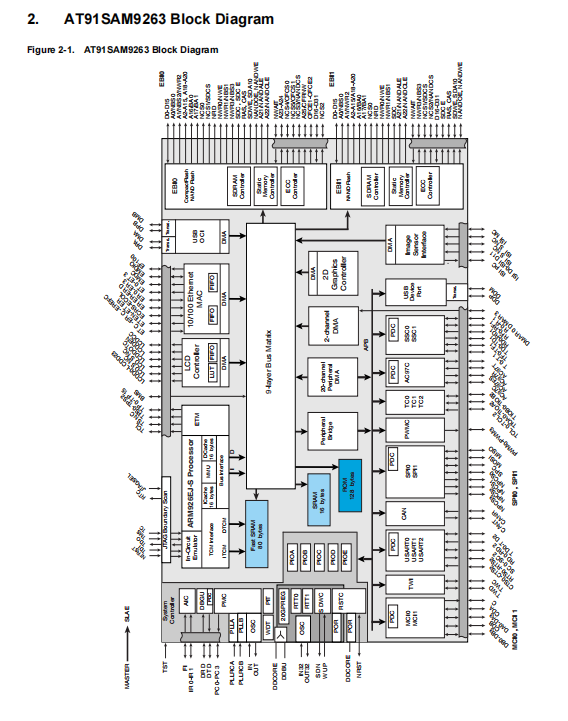1. Features
• Incorporates the ARM926EJ-S™ ARM® Thumb® Processor
– DSP Instruction Extensions, Jazelle® Technology for Java® Acceleration
– 16 Kbyte Data Cache, 16 Kbyte Instruction Cache, Write Buffer
– 220 MIPS at 200 MHz
– Memory Management Unit
– EmbeddedICE™, Debug Communication Channel Support
– Mid-level Implementation Embedded Trace Macrocell™
• Bus Matrix
– Nine 32-bit-layer Matrix, Allowing
a Total of 28.8 Gbps of On-chip Bus Bandwidth
– Boot Mode Select Option, Remap Command
• Embedded Memories
– One 128 Kbyte Internal ROM, Single-cycle Access at Maximum Bus Matrix Speed
– One 80 Kbyte Internal SRAM, Single-cycle Access at Maximum Processor or Bus Matrix Speed
– One 16 Kbyte Internal SRAM, Single-cycle Access at Maximum Bus Matrix Speed
• Dual External Bus Interface (EBI0 and EBI1)
– EBI0 Supports SDRAM, Static Memory, ECC-enabled NAND Flash and CompactFlash®
– EBI1 Supports SDRAM, Static Memory and ECC-enabled NAND Flash
• DMA Controller (DMAC)
– Acts as one Bus Matrix Master
– Embeds
2 Unidirectional Channels with Programmable Priority, Address Generation, Channel Buffering and Control
• Twenty Peripheral DMA Controller Channels (PDC)
• LCD Controller
– Supports Passive or Active Displays
– Up to 24 bits per Pixel in TFT Mode, Up to 16 bits per Pixel in STN Color Mode
– Up to 16M Colors in TFT Mode, Resolution Up to 2048x2048, Supports Virtual Screen Buffers
• Two D Graphics Accelerator
– Line Draw, Block Transfer, Clipping, Commands Queuing
• Image Sensor Interface
– ITU-R BT. 601/656 External Interface, Programmable Frame Capture Rate
– 12-bit Data Interface for Support of High Sensibility Sensors
– SAV and EAV Synchronization, Preview Path with Scaler, YCbCr Format
• USB 2.0 Full Speed (12 Mbits per second) Host Double Port
– Dual On-chip Transceivers
– Integrated FIFOs and Dedicated DMA Channels
• USB 2.0 Full Speed (12 Mbits per second) Device Port
– On-chip Transceiver, 2,432-byte Configurable Integrated DPRAM
• Ethernet MAC 10/100 Base-T
– Media Independent Interface or Reduced Media Independent Interface
– 28-byte FIFOs and Dedicated DMA Channels for Receive and Transmit
• Fully-featured System Controller, including
– Reset Controller, Shutdown Controller
– Twenty 32-bit Battery Backup Registers for
a Total of 80 Bytes
– Clock Generator and Power Management Controller
– Advanced Interrupt Controller and Debug Unit
– Periodic Interval Timer, Watchdog Timer and Double Real-time Timer
• Reset Controller (RSTC)
– Based on Two Power-on Reset Cells, Reset Source Identification and Reset Output Control
• Shutdown Controller (SHDWC)
– Programmable Shutdown Pin Control and Wake-up Circuitry
• Clock Generator (CKGR)
– 32768Hz Low-power Oscillator on Battery Backup Power Supply, Providing
a Permanent Slow Clock
– 3 to 20 MHz On-chip Oscillator and Two Up to 240 MHz PLLs
• Power Management Controller (PMC)
– Very Slow Clock Operating Mode, Software Programmable Power Optimization Capabilities
– Four Programmable External Clock Signals
• Advanced Interrupt Controller (AIC)
– Individually Maskable, Eight-level Priority, Vectored Interrupt Sources
– Two External Interrupt Sources and One Fast Interrupt Source, Spurious Interrupt Protected
• Debug Unit (DBGU)
– 2-wire UART and Support for Debug Communication Channel, Programmable ICE Access Prevention
– Mode for General Purpose Two-wire UART Serial Communication
• Periodic Interval Timer (PIT)
– 20-bit Interval Timer plus 12-bit Interval Counter
• Watchdog Timer (WDT)
– Key-protected, Programmable Only Once, Windowed 16-bit Counter Running at Slow Clock
• Two Real-time Timers (RTT)
– 32-bit Free-running Backup Counter Running at Slow Clock with 16-bit Prescaler
• Five 32-bit Parallel Input/Output Controllers (PIOA, PIOB, PIOC, PIOD and PIOE)
– 160 Programmable I/O Lines Multiplexed with Up to Two Peripheral I/Os
– Input Change Interrupt Capability on Each I/O Line
– Individually Programmable Open-drain, Pull-up Resistor and Synchronous Output
• One Part 2.0A and Part 2.0B-compliant CAN Controller
– 16 Fully-programmable Message Object Mailboxes, 16-bit Time Stamp Counter
• Two Multimedia Card Interface (MCI)
– SDCard/SDIO and MultiMediaCard™ Compliant
– Automatic Protocol Control and Fast Automatic Data Transfers with PDC
– Two SDCard Slots Support on eAch Controller
• Two Synchronous Serial Controllers (SSC)
– Independent Clock and Frame Sync Signals for Each Receiver and Transmitter
– I²S Analog Interface Support, Time Division Multiplex Support
– High-speed Continuous Data Stream Capabilities with 32-bit Data Transfer
• One AC97 Controller (AC97C)
– 6-channel Single AC97 Analog Front End Interface, Slot Assigner
• Three Universal Synchronous/Asynchronous Receiver Transmitters (USART)
– Individual Baud Rate Generator, IrDA® Infrared Modulation/Demodulation, Manchester Encoding/Decoding
– Support for ISO7816 T0/T1 Smart Card, Hardware Handshaking, RS485 Support
• Two Master/Slave Serial Peripheral Interface (SPI)
– 8- to 16-bit Programmable Data Length, Four External Peripheral Chip Selects
• One Three-channel 16-bit Timer/Counters (TC)
– Three External Clock Inputs, Two Multi-purpose I/O Pins per Channel
– Double PWM Generation, Capture/Waveform Mode, Up/Down Capability
• One Four-channel 16-bit PWM Controller (PWMC)
• One Two-wire Interface (TWI)
– Master Mode Support, All Two-wire Atmel® EEPROMs Supported
• IEEE® 1149.1 JTAG Boundary Scan on All Digital Pins
• Required Power Supplies
– 1.08V to 1.32V for VDDCORE and VDDBU
– 3.0V to 3.6V for VDDOSC and VDDPLL
– 2.7V to 3.6V for VDDIOP0 (Peripheral I/Os)
– 1.65V to 3.6V for VDDIOP1 (Peripheral I/Os)
– Programmable 1.65V to 1.95V or 3.0V to 3.6V for VDDIOM0/VDDIOM1 (Memory I/Os)
• Available in
a 324-ball TFBGA Green Package


